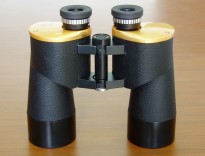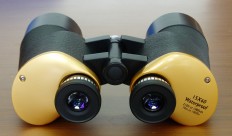

This is the smallest of a series of astro-binoculars, containing a 15x60, 20x80 and 25x100 (which is e.g. sold by Celestron), and exported by United-Optics. It appears to be identical with the Barska Cosmos (not confirmed information), which is sold for about 165 Dollars.
Left: Mounted on tripod. Right: Coating and internal tube.
| Real angle | Apparent angle | Eye relief | Exit pupil | Weight | |
| of view (deg) | of view (deg) | (mm) | diam. (mm) | (kg) | |
| BA4-1560 | 4.0 | 60 | 15.5 | 4 | 1.8 |
The BA4-1560 is sharing its body construction with the larger variants of that series and is dimensioned accordingly, with massive prism-clusters and a robust central hinge. This is a heavy glass, but it is claimed to be waterproof. All mechanical movements appear well done and without play, although the left ocular is turning a little tight. The cover of the prism-house is fixed with a single screw only, and this screw appears a bit undersized. This binocular comes with a rain guard for the oculars and soft-rubber objective covers. The latter are too loose, however, and easily fall off. The eye-cups are made of soft rubber and fold either up or down (no intermediate distance is possible), but the eye-relief may be a little short to get the full angle of view with eye-glasses on. The fact that the same body has to carry 100mm objectives in the larger version leads to the consequence that the 60mm objectives are quite far apart. This binocular has therefore got an excellent stereoscopic view even when observing objects of considerable distance, e.g. ships on the sea. Although, in a comfortable chair, it is possible to use this glass free handed for a short time, it quickly becomes too heavy so that it is generally better mounted on a tripod.
The image is of moderately wide angle (60 degs. apparent field) and bright to the edge, i.e. there is no apparent vignetting. The exit-pupils are round and apparently not stopped down, as I have observed with some other Chinese binoculars. This indicates that the bulky prisms of this device are properly dimensioned. The image sharpness is very good in the central region. From about 70% outwards (radially off center), star images begin to show some blur, and 90% off center the aberrations are reaching a high level. Through the left barrel I have noticed a slight amount of coma, only visible if a bright star is observed. This did not seem to affect the image sharpness during daytime observations. I have observed that the ocular only allows for little tolerance regarding the eye-position: The eye-pupil has to be very accurately aligned with the exit pupil, otherwise the area of sharpness is decreasing and chromatic aberration shows up, even in the central part. This is no problem during daytime, if the binocular is mounted on a tripod and carefully adjusted for observation. For astronomical use, however, the binocular points upwards, and one is often forced to observe in an uncomfortable angle. Under these conditions, one may not always be able to exploit the full performance of this instrument.
This binocular has got a couple of features to prevent stray light. Looking through the objectives, an internal tube is visible that shields the prism-entrance. The inner walls of the objective tubes are properly painted black. During daytime and in the night this binocular is essentially free of stray light. Under difficult light conditions, in twilight or if a bright light source (moon) is just outside the field, there is some stray light showing up. It forms a diffuse ring close to the outer edge of the field. Perhaps the inner tube with its shiny edge is the culprit, but this is hard to judge without opening the instrument. This stray light remains localized at the edge, anyway, and does not destroy the overall contrast of the image. Ghosting is on a moderate level. The full moon is causing some ghosts of low intensity. Again, there is a dependence on the eye-to-exit-pupil distance: If this distance is not close to its optimum, ghosting can increase a lot. For a binocular of this price class the coating is altogether reasonably good.
In summary, this binocular provides sufficient performance to shift it beyond the low-range region into the medium-range division. This glass outperforms some of the cheaper 'Giant-binoculars' coming from China, because it is of superior mechanical construction and comes with large prisms, which allow for a wide and bright-to-the-edge image without the need to stop down the exit pupils. It is not only suited for astronomy, but as well for long-range terrestrial observations, also under bad weather conditions. There are a couple of points that indicate compromises, however. A slight amount of coma, although of little impact, may indicate a misalignment. The oculars are somewhat 'intolerant', means that they require an accurate placement of the eyes to show optimum performance. But we have to acknowledge that the price tag is fair, and to expect performance on Fujinon-level would be naive. This is a fine instrument for someone who doesn't want to spend a premium but still expects a reasonable value for his money.
Last updated: Sept. 2005